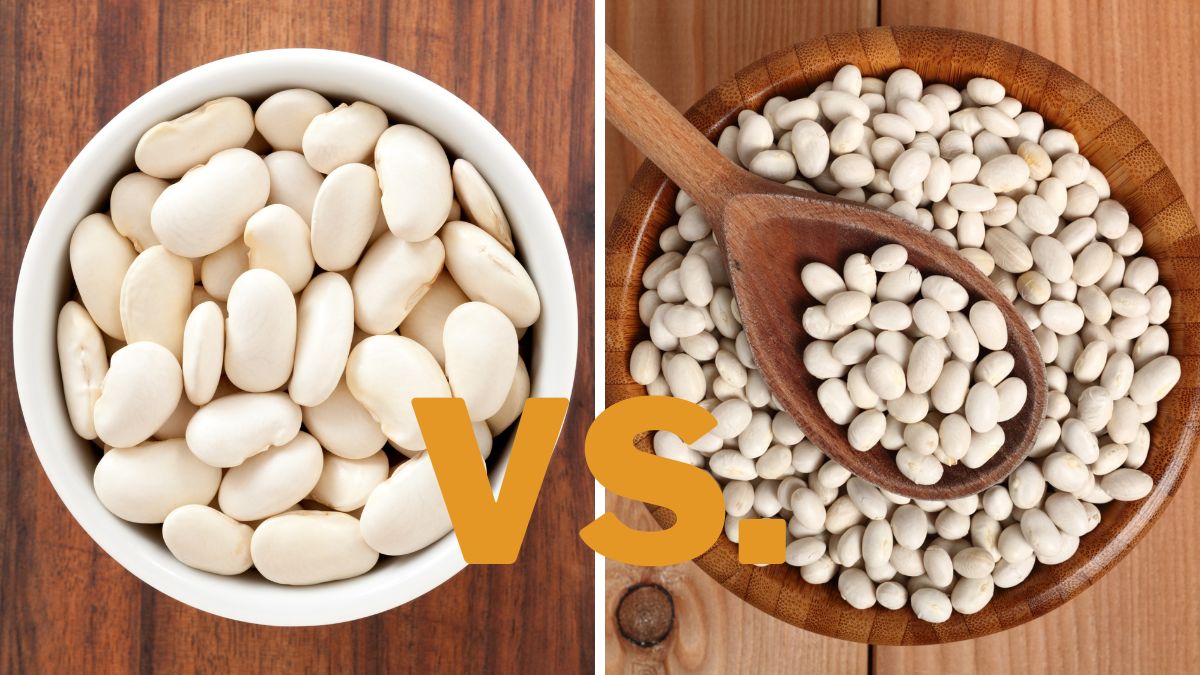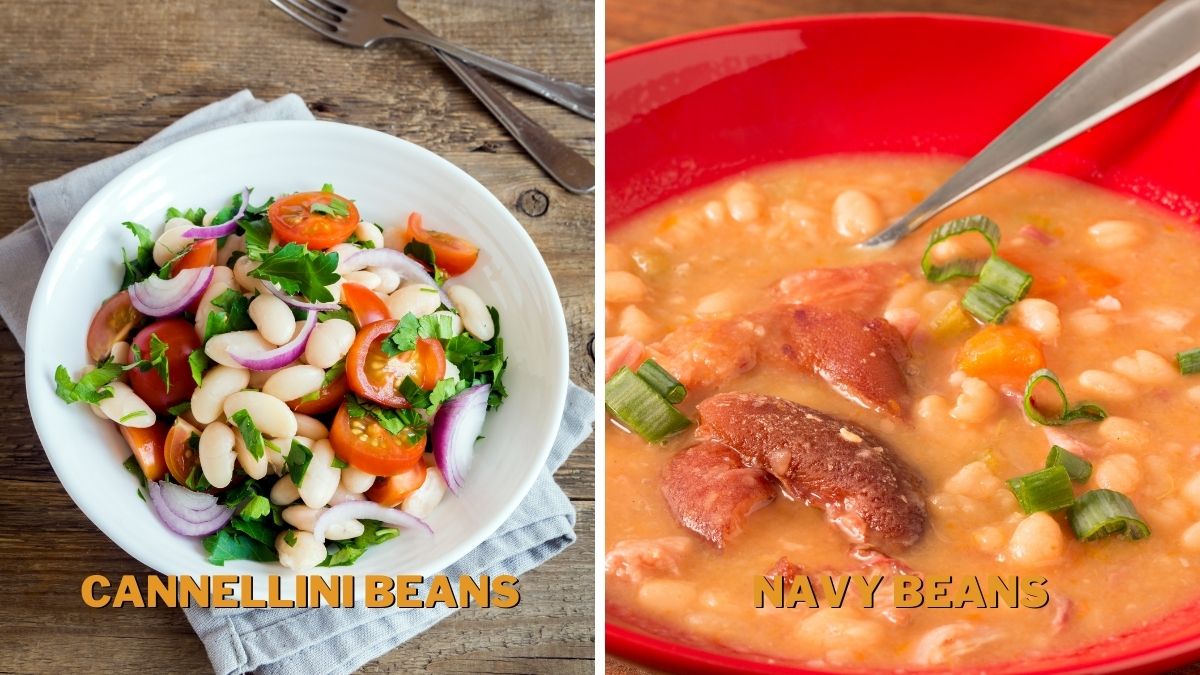Cannellini Beans vs. Navy Beans: Differences & Which Is Better?

Stew season starts the moment temperatures drop. Beans have so many varieties and alternatives to pick out. When the recipe says to add white beans, you’ll realize that is a much larger term than you expected. The two most popular among them are kidney and small white beans. So, what are the differences between cannellini and navy beans?
Cannellini and navy beans are very similar in appearance, yet navy is milder in taste and creamier in texture. For soups and baked beans, opt for navy but cannellini for salads. Furthermore, they are both extremely nutritional.
When you step aside from standard recipes and think out of the box, you’ll discover a whole new world of food. Don’t avoid trying new flavors and combinations, as beans are an unexpectedly good base for making cakes and confections. Read further to get an insight into the taste, preparations, nutritional values, and some ideas on introducing more beans to your diet.
Cannellini Beans vs. Navy Beans: Differences
You may think all white beans are the same, but cannellini is Italian and navy native American food. Both are suitable for many delightful dishes, from stews to cupcakes.
Appearance
When comparing cannellini and navy beans by their looks, you could say they are much alike. They are both white and often mixed with one another.
Cannellini beans have their signature kidney-shaped look, and they are the largest type among all white beans. On the other hand, navy beans are much smaller and have a pea-like shape. If we look at little things too, cannellini is creamy, while navy bean is a pearly shade of white.

Taste
Navy beans have a very neutral taste. That’s why they are able to blend in numerous dishes, sweet and savory. As they are very starchy, cooked navy beans have a soft and buttery texture. The base note is rather nutty and woody.
When speaking of cannellini beans, they have notably different tastes. It is more powerful and leaves an earthy aftertaste. These beans have thin but solid skin and a meaty and tender texture. Due to that, they keep their shape after cooking.
Preparation
When using canned beans, either cannellini or navy, wash them thoroughly in cold water. After that, you just need to drain them, and you’re good to go. Rinsing is necessary as it removes the residual salt of bean water.
If you opt for dried beans, the first thing is to soak them for at least 5 to 6 hours, preferably overnight. Before cooking them, rinse them again. You can’t cook them for less than an hour but approximately 1 to 2 hours for the best taste.
Moreover, don’t boil beans at high temperatures because they will absorb too much water in a short time and split. So, simmer them at low or medium temperatures for them to rehydrate well. Keep an eye on the water level, don’t let it evaporate too much since the optimum is one to three fingers of water above the beans.
Don’t forget to use a larger pot, as they will become more massive while cooking. Also, don’t add any salt right away, as salt tends to thicken the skin. When you bring them to the boiling temperature, let them simmer for about 15 minutes in water alone, and remove the foam a few times.
In case you forgot to soak your beans, don’t worry. You can still prepare them without drenching them in advance, yet they will take longer to cook. Some recipes, indeed, request dried beans as they build exceptional bouillon.
So, navy beans are the chief base for many dishes. When pureed, their creaminess reaches its full potential. Pates, dips, and simple purees are among the high-end delicacies you can easily make at home.
Pate with navy beans, sun-dried tomatoes, and garlic is a fun dip to serve with bruschetta or fresh veggies. For a dash of East, try navy beans and tahini hummus. Serve it with pita bread for a complete experience.
Cannellini beans can also be pureed, but navy beans puree has a silkier texture and it’s more popular. Chicken broth is a common addition for achieving a softer texture and elevating the taste. For a vegan option, you can use vegetable broth, too.
They play well with different spices but try it first with the simplest ones: sea salt, pepper, and garlic as a base. Either olive oil or butter will complement their tastes, too. From there, you can add thyme, paprika, lemon juice, and many more to build the taste you’ll like.
Baked navy beans are an American gem. Boston baked beans are the most celebrated variety, as a pivotal choice for every barbecue. This dish is a fusion of flavors, as it contains strong ingredients for all senses.
Cannellini beans are famous as a great addition to salads, thanks to maintaining their shape. The star of Italian cuisine is cannellini and tuna salad, sprinkled with homemade olive oil and lemon juice. It pairs fantastically with fresh vegetables, such as cherry or grape tomatoes, cucumber, and red onion.
If you want some soul food on these winter days, try goulash, chili, or soup with white beans. Cannellini goes wonderfully with beef, pork, and/or with carrot, paprika, and potato for a vegan option. Navy bean soup is creamier and herbs-friendlier, as they have a milder taste. Pair it with a good cut of ham, and winter vegetables along with dry herbs, and you’ll get a full one-pot meal.

Nutrition
Both navy and cannellini beans are nutritional gems. They are rich in fiber, protein, and micronutrients. Copper, folate, and iron are in the hall of fame of micronutrients.
They are a good source of plant-based protein, considering that cannellini beans have 17 grams while navy beans have 15 grams per cup. [1] [2] They have pretty much the same amounts of calories, but navy beans have a bit more fat. What’s more, they have more dietary fibers on the total carbs scale.
When speaking of micronutrients, there is slightly more iron and copper in cannellini beans, while there are more folate, manganese, and vitamins B9 and B1 in navy beans. [3] After this information, we can conclude that white beans are a serious ingredient to include in your diet.
Vegans and vegetarians use beans as a primary source of protein, but they don’t contain all amino acids though. When paired with grains, they make a complete protein. They are also weight-loss-friendly, as they have low calorie but high nutritional count.
Plus thing is that they improve digestion and lower bad cholesterol. But be careful if you’re using canned beans, as they can contain nitrites and salt, so always rinse them.
Cannellini Beans vs. Navy Beans: Which Is Better?
Which variety of beans is better, depends only on your personal preference. They are both healthy and highly nutritional, but also very delicious. If you enjoy salads, opt for cannellini, and for creamy pottages, choose navy.
Can You Substitute Navy Beans for Cannellini Beans?
You can definitely substitute navy for cannellini beans, and vice-versa. They have similar tastes, and pair nicely with the same ingredients. The flavor won’t change significantly and it’s nothing that can’t be masked with a bit of spice.
